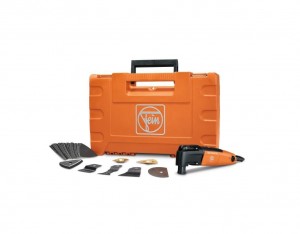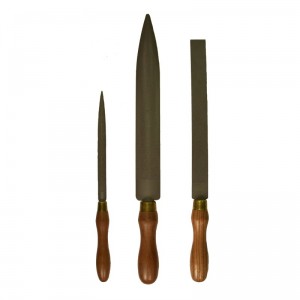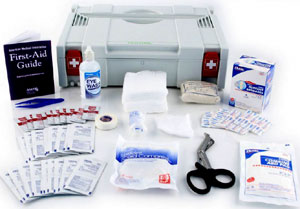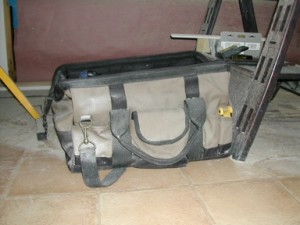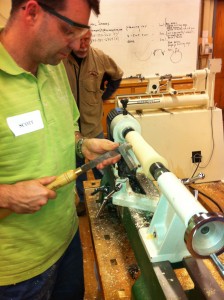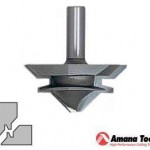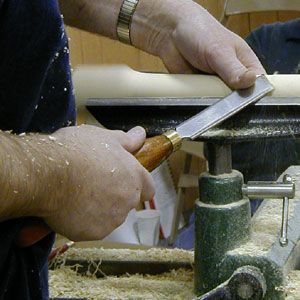It occurs to me that many of the people who frequent this Blog would be interested in one of my favorite things, i.e. Habitat for Humanity. Not to be bragging, but I am probably up to 75 houses that I have worked on in some fashion or other over the years. A few more and maybe I will learn how to actually build a house. Let me tell you about it.
The system is pretty typical around the country. A corporate sponsor or group or individual comes forward and offers the money needed to purchase the land and the building materials. Then the sponsor or group will collect volunteers (that’s you, Pilgrim) to come and actually do the construction work. In my local Chapter, we look for about 30 to 35 people per day on the site, and we schedule about ten days to complete a 1400 square foot house. The Chapter obtains the land and the building materials, the permits and licenses, and provides essential construction expertise. The skilled trades which require licenses will be hired by the Chapter.
Once everything is in place, construction begins and that is the really fun part. Day One and Day Two are the best. In our Chapter, we are sorely disappointed if all the walls are not standing by the end of the first day. Roof trusses are usually scheduled on Day Two and the rest of the work proceeds from there.
One of the real joys of the construction time is working with the family who will live in the house. A requirement for purchasing (that’s right — purchasing) a Habitat House is the sweat equity investment. Before we will sell the house to a family, they must put in 250 hours (logged in and out) working on either their house or someone else’s Habitat house. Plus they must attend a 50 hour course on financial management as taught by Dave Ramsey of radio fame. Once they have made the hours and completed the course work and shown they can handle the payments, then we sell the house to them for the cost of materials and land. We provide a twenty year mortgage at zero per cent interest. At the end of twenty years, the house belongs to the family with no further obligation to Habitat.
But then, you ask, if the materials are furnished by the sponsor, and the labor is all volunteer, why is there a mortgage? The answer is that we take the money which comes in from the mortgages, pay a minimal staff, and then use the rest as seed money to build more houses. It is somewhat like a benevolent Ponzi scheme. Our Chapter for instance has built about 125 houses so we have around 125 mortgage payments coming in each month. Larger Chapters have built 1500 or more houses.
Habitat works all around the world. In fact, as a salute to our Christian beginnings, we tithe our monetary donations. Turns out you can build a house in Guatemala for about $3000. As a result, Habitat International recently celebrated construction of its 500,000th home. Corporate Donors also step up constantly. For example, Whirlpool Corporation donates a stove and refrigerator to every single house built in America by Habitat. When we finish a house, we call Whirlpool and they send them out. That’s why I buy Whirlpool every chance I get. Blessings on them and hundreds of others who do likewise.
How do you fit into this scheme? Call your local Chapter and see what you can do. Start by showing up on the site one day to offer your labor in construction. Look around and see what they need. What you will find is a bunch of good people doing something they love for the benefit of someone who will never have a home any other way. Match your skills to their needs and it will be a good thing for both of you. Go do some good!!
Monday, December 19, 2011
Christmas Wish List
Christmas is coming and it is time to look at the old wish list. My family laments the fact that I have all the $30 woodworking tools. Anything I still need/want is going to be more. Assuming you have been a good boy or girl, perhaps it will be a fruitful year in the workshop. For the sake of any of you friends and family (particularly my son Jon) who might be looking for something to grace this old blogger, here is my list for this year. Maybe there is something you might like on my list.
1. I would like to be able to write songs like Brian Wilson of the Beach Boys and sing like George Younce of the Cathedrals. Oh wait, did you say this was a Wish List for a Woodworking store? Sorry, those two just slipped out.
2. Hollow Chisel Mortiser — Highland has a top notch power mortiser from Steel City for $299.99. I saw it in the store this week and it is high on my list. If you do a fair amount of mortise and tenon joints, then this tool may be just right for you. It is bench mounted and has a rack and pinion adjustable fence for easy alignment. The handle adjusts to six positions and is reversible. The switch is right up front and easy to reach. The bits lock into the spindle and there should be none of that twisted bits stuff which is so irritating on lesser models. This thing looks like an excellent medium duty machine for the serious amateur mortise maker.
3. ANYTHING from Festool. I have not started my Festool collection yet, but these tools are always on my list. Given my choice, I would start with the chop saw, then the router, and then the sanders with the vac.
When I was working on my rocking chair, Charles Brock in his shop had the heavy duty Festool sander hooked up to the Festool vacuum and it is a sweet operation. Probably not going to happen this year, but perhaps if I am very, very good next year.
4. Sawstop Table Saw — Highland can ship the SawStop Contractor Saw to all the lower 48 states now and if you are looking at a table saw, you owe it to your spouse and family to keep all your fingers. Touted as the safest table saw out there, don’t ask for any other saw without looking seriously at this one. Watch the famous hot dog video, (or the chicken leg demo) and you will be a fan.
5. Fein MultiMaster — I have seen the commercials on TV for this thing. What really convinced me, however, was when the construction manager at my Habitat for Humanity chapter pulled one of these out of his truck. We needed to notch out a board to set a marble counter top, and there was no good way to do the work without tearing half the wall down. We turned this thing on and in about 30 seconds, the job was done. Be careful, though because there are many lower-quality imitators out there, ranging from the $29.95 version at the tool discount store to somewhat more expensive models from some of the major manufacturers. The real thing may seem a little pricey, but it is worth every penny. Also do some research on the blades, because there is a very wide range of quality available in blades and they can be a costly error if you get the wrong ones. The Fein Multimaster model I would like is the FMM 250Q Select Plus kit, which until recently sold for $329, but is available at Highland right now for $299. It should do almost all I need right now, and I can always buy accessories for it as I need them.
6. Auriou Chairmaker’s Rasp Set — If you have never used one of these things and all you have ever tried is one of those five dollar rasps from the local hardware, then you are in for a revelation. I had never used one of these things until I worked on a sculptured chair. Who knew that the single biggest issue with one of these beautiful tools is you have to be careful to not remove too much wood.
How many hand tools do you use where taking off too much wood is the main problem? Most of the time, I have trouble just getting tools to cut in the first place. Well, you say, I sure as heck ain’t paying that much money for a stupid rasp. Well, nay, I say, nay! First of all, these rasps will last the rest of your life and your children will bless you for them. Second, once you try them you will wonder how you missed them your whole woodworking life. Just try one and you will agree with me. (By the way, Jon, I like the set of three for $349.99.)
There you go. Slide this list under the door for somebody, or leave it open on the computer. Or print it out and leave it under the breakfast cereal. If you don’t score any of these things this year, try being gooder next year. I’ll let you know how it worked out for me.
1. I would like to be able to write songs like Brian Wilson of the Beach Boys and sing like George Younce of the Cathedrals. Oh wait, did you say this was a Wish List for a Woodworking store? Sorry, those two just slipped out.
2. Hollow Chisel Mortiser — Highland has a top notch power mortiser from Steel City for $299.99. I saw it in the store this week and it is high on my list. If you do a fair amount of mortise and tenon joints, then this tool may be just right for you. It is bench mounted and has a rack and pinion adjustable fence for easy alignment. The handle adjusts to six positions and is reversible. The switch is right up front and easy to reach. The bits lock into the spindle and there should be none of that twisted bits stuff which is so irritating on lesser models. This thing looks like an excellent medium duty machine for the serious amateur mortise maker.
3. ANYTHING from Festool. I have not started my Festool collection yet, but these tools are always on my list. Given my choice, I would start with the chop saw, then the router, and then the sanders with the vac.
When I was working on my rocking chair, Charles Brock in his shop had the heavy duty Festool sander hooked up to the Festool vacuum and it is a sweet operation. Probably not going to happen this year, but perhaps if I am very, very good next year.
4. Sawstop Table Saw — Highland can ship the SawStop Contractor Saw to all the lower 48 states now and if you are looking at a table saw, you owe it to your spouse and family to keep all your fingers. Touted as the safest table saw out there, don’t ask for any other saw without looking seriously at this one. Watch the famous hot dog video, (or the chicken leg demo) and you will be a fan.
5. Fein MultiMaster — I have seen the commercials on TV for this thing. What really convinced me, however, was when the construction manager at my Habitat for Humanity chapter pulled one of these out of his truck. We needed to notch out a board to set a marble counter top, and there was no good way to do the work without tearing half the wall down. We turned this thing on and in about 30 seconds, the job was done. Be careful, though because there are many lower-quality imitators out there, ranging from the $29.95 version at the tool discount store to somewhat more expensive models from some of the major manufacturers. The real thing may seem a little pricey, but it is worth every penny. Also do some research on the blades, because there is a very wide range of quality available in blades and they can be a costly error if you get the wrong ones. The Fein Multimaster model I would like is the FMM 250Q Select Plus kit, which until recently sold for $329, but is available at Highland right now for $299. It should do almost all I need right now, and I can always buy accessories for it as I need them.
6. Auriou Chairmaker’s Rasp Set — If you have never used one of these things and all you have ever tried is one of those five dollar rasps from the local hardware, then you are in for a revelation. I had never used one of these things until I worked on a sculptured chair. Who knew that the single biggest issue with one of these beautiful tools is you have to be careful to not remove too much wood.
How many hand tools do you use where taking off too much wood is the main problem? Most of the time, I have trouble just getting tools to cut in the first place. Well, you say, I sure as heck ain’t paying that much money for a stupid rasp. Well, nay, I say, nay! First of all, these rasps will last the rest of your life and your children will bless you for them. Second, once you try them you will wonder how you missed them your whole woodworking life. Just try one and you will agree with me. (By the way, Jon, I like the set of three for $349.99.)
There you go. Slide this list under the door for somebody, or leave it open on the computer. Or print it out and leave it under the breakfast cereal. If you don’t score any of these things this year, try being gooder next year. I’ll let you know how it worked out for me.
Thursday, October 20, 2011
The Fullsized Finisher
Did you ever notice how we have these woodworking cliches? We never “grab a chisel”, we always “grab a sharp chisel”. Let me think about that for a second. I want to make a fine paring cut on a piece of hard maple, so I think I will get my dull chisel. In my profession, the Attorney General of the State of Georgia got involved one time in a legal opinion about Land Surveyors. Question was whether we had to call ourselves “Registered Land Surveyors” or simply “Land Surveyors”. His legal opinion was that if you were not registered then you were not a land surveyor. There are only “Land Surveyors”, and any label past that was superfluous. I agree — no more “sharp” chisels, only “chisels”.
Same thing happens in woodturning — we never have a catch, we always have a “nasty” catch. I agree that catches are always nasty, and I still hate them. They scare me pretty good most of the time.
I was practicing last week with the next tool in the Easy Wood Tool group, the Full Finisher. Watch the video below and you can see how it works. It really is a smooth cut and you can get quite aggressive with it. The piece was wet, ash I think, and I had roughed it out a few days before and then put it back on the lathe to round it off and thin it out.
What I think a lot of woodturners miss is listening to the sound of the tool cutting. You can tell a lot by the sound the tool makes as it cuts. After a while, the tool makes a steady droning sound and you can tell when you get some wobble in the shape and the tool is not following very well. You get a little bit of that high pitched wail from movies set in the Middle East where the men are going off to war and the women are cheering them from the top of the cliffs. Listen to the sound I left in the video and you will see what I mean.
I went to a class with a bunch of beginners one time and the sounds in the room drove me up the wall. Even at that early stage of my turning career, I could hear the pieces beginning to break apart, but the people doing the work had no idea what was about to happen. Now and then one would explode and fly all over the room, but somehow that was easier to take than waiting for one to bust once I heard that sound.
I think I overstepped the capability of the Easy Finisher with the size of the bowl I was using it on. Probably overstepped my capability also. I went back to the Easy Tools web site and watched their demonstration again, and they were working on a smaller bowl. I think that may be the key. That and a lot more practice.
It is hard for me to watch the video cause I know what’s coming. Maybe we should call all catches nasty. Least I didn’t cuss, I just hollered. Or screamed like a little girl, whichever you think. Let’s see what you say if it happens to you.
Tuesday, May 24, 2011
Tool Kit
 Sometimes I worry about us woodworkers. We tend to go off to our shops and isolate ourselves from the world. (Did you hear about the guy who always stayed at home because he didn’t want to have to kiss his wife goodbye?) As a follow-up to our safety week and as a public service, I call attention to a bulletin issued last week by the Center for Disease Control and Prevention in Atlanta. Use this information to stay safe and keep buying tools.
Sometimes I worry about us woodworkers. We tend to go off to our shops and isolate ourselves from the world. (Did you hear about the guy who always stayed at home because he didn’t want to have to kiss his wife goodbye?) As a follow-up to our safety week and as a public service, I call attention to a bulletin issued last week by the Center for Disease Control and Prevention in Atlanta. Use this information to stay safe and keep buying tools.The CDC issued guidelines to follow in case of a Zombie Apocalypse. (You may think I am making this up, so here is the actual real link). This warning really hit home with me since my shop is in the back yard in the deep woods so to speak, and it can get really spooky (not to mix metaphors) out there at night. After dark with the lights on in the shop, you cannot see what is going on outside, and when you get absorbed in a delicate little dovetail joint, the whole world could end around you and you would hardly know it until it was too late to do anything about it (as if you could). I have often wondered what steps I would need to take in case zombies (the technical term for the condition is Ataxic Neurodegenerative Satiety Deficiency Syndrome) showed up at the shop. For instance, the CDC recommends that you set up a meeting place outside the home so your family can rendezvous and escape together to a zombie-free refugee camp. They post a list of supplies to take with you including water and food and a first aid kit, though they do admit that once bitten the first aid kit will not be of much use.
The thing they are missing though, is defensive tools to protect yourself from a zombie attack. I think woodworkers are particularly well-equipped to protect themselves with things both portable and effective already in nearly every woodworking shop. My lathe skew chisel (properly sharpened) with its slanted blade and sharp point would be very effective in zombie defense. My battery powered drill (I will need to keep the batteries charged better than I normally do) with a two inch spade bit would be helpful. Oh wait, how about the drill mounted three inch hole saw -- I think that would be better. The battery powered reciprocating saw is an awesome tool, effective in many situations where no other tool will work. If you have ever caught your finger in one of those Japanese cut-off saws, you will recognize what damage that thing could do when properly applied to larger fleshy appendages. And as in most woodworking operations, having this saw cutting on the pull stroke makes it much easier to use when you are in a rush to finish a project. Last but not least, is my chain saw. I prefer a 20 inch blade to give me a little more depth of cut, and you don’t need a really big saw -- too heavy to lift to shoulder height on a continuing basis. Just make sure it has the proper gas and oil mix so you can get it started easily. When you need it, you need it quick.
I am going to recommend to the store that we put together a Highland Zombie Apocalypse Preparedness Kit. It should include all the materials recommended by the CDC, plus the things I have suggested. I think we will put it in a big tool bag so you can grab it and go on short notice. The problem with that is you will not be able to use the tools from the Kit without taking a chance on missing some of them when you have to leave in a rush. Just use them and put them back in the Kit when you are done. We are open to suggestions here people. Send us your ideas and perhaps you will see them incorporated into our Kit. Now go fuel up the chain saw. Be prepared!! Stay safe. Keep your brain.
Monday, April 11, 2011
Skew Class: Conquering my Fears
I hesitate to say I have tamed the skew, but at least I can live in the same house with it now.
I went to the “Taming of the Skew” class at Highland last week and we spent three good hours with Hal Simmons, a professional turner, to try to solve some of the problems many people have trying to use a skew chisel.
We started out by learning how to sharpen the thing, first on a grinding wheel and then to a flat stone. As with almost any woodworking operation, having a sharp tool is a good thing. Hal asked each of us in turn what experience we had and what our issues were with the skew. After some discussion we moved to the fun part and we all got a good laugh. When Hal had a square piece of wood set up in the demonstration lathe, he turned the lathe up to very high speed and prepared to stick the skew into the wood. The whole class scattered like a flock of buzzards when a car comes along and Hal was standing there by himself. Apparently we all shared the same fear of the skew.
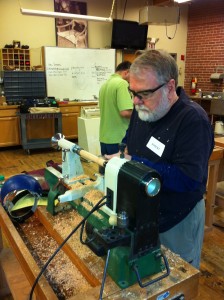
- Trying to Tame It
Once he calmed us all down and got us back to the demo lathe, he demonstrated how to use the skew to round off a work piece. He was standing there rounding that wood and not even looking at it, and we were all standing around with our mouths open and pleading with him to watch the work, because we were absolutely positive we knew what was going to happen and it was not going to be pretty.
After we learned the basic planing cut, we moved into cutting a groove and then to widening that groove into all those beautiful shapes found on candle holders and chair legs and balusters. The cuts are simple in theory when explained well, but as with most skills, take a while to develop the proper motions. It's the same answer you get in New York City when you ask someone how to get to Carnegie Hall. Practice, Practice, Practice!
At least I am not afraid of the tool anymore, and with a lot of practice I should be able to make some nice stuff. What a great class and it is offered every few months at the High. It runs from 5:30 to 8:30 in the evening and only costs $75. Go ahead, tame that skew!!
By the way if you are a Kindle owner, click over to Amazon and check "Blogs" for Kindle and look me up. You can subscribe and have this automatically downloaded into your Kindle. See You There!!
By the way if you are a Kindle owner, click over to Amazon and check "Blogs" for Kindle and look me up. You can subscribe and have this automatically downloaded into your Kindle. See You There!!
Wednesday, March 30, 2011
Router Table, Router and Custom Moldings
Don’t “Duh” me please. And why would you say “Duh”? Because it took me this long to figure I can make my own moldings. Until the last couple of years I only made things where I could use stock moldings from the big box store. That beginning point limited me severely and I could only do things which were going to be painted or where finger joints are acceptable (a small portion of fine woodworking to be sure). I finally figured out from watching Mr. Norm and then getting a good router table in my shop that I can make many very nice moldings out of any wood I choose. And I don’t have to paint it or try to explain to all my friends that finger jointing is a tree saving environmentally correct methodology and the reason I am charging more for my work.
Over the past couple of months I have been making some small furniture pieces for my church and I wanted them to match the existing pulpit furniture. Both of the latest pieces are from oak, one red oak and the other quarter sawn white oak. Needless to say, there are not many custom moldings from those two species and I really wanted them to match.
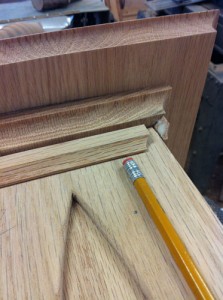
- Can’t buy this!
A few months ago, I purchased the Kreg router table with a new Triton Router from Highland. What a beautiful setup that is. I already had a set of half inch router bits and I figured I might as well try the molding process. It worked!! I came up with some beautiful stuff and it made the finished project look good. What works for me is to plane a board to a good thickness and then rout one edge (or both edges) by running it at the router fence. I then cut the molding off the edge of the board at the table saw and it is done. I can make as much as I want and it is always the right size and species for the project. Miter it up, nail it up and stand it up.
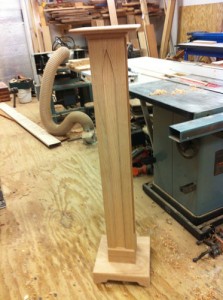
- Waiting for Stain and Finish
One of the great joys of woodworking is doing the final fit of those last little delicate moldings on a project. There is a timelessness about it which feeds my soul, particularly when I think about spending an extra half hour doing something really well, so people a hundred years from now will touch it and run a finger along it and recognize that someone cared enough to do it really well. Isn’t that why you do woodworking?
Posted by terrychapman at 3:03 pm No Responses »
Monday, March 21, 2011
Redacted Furniture
Do you know what it means when something is “redacted”? I think of documents the federal government reluctantly gives up under the Freedom of Information Act where they don’t want you to know what or who they are talking about, so they black out every other word of it and send it to you so they have met the letter of the law but you really don’t know what they are talking about once you see it.
Last year I found a new sales avenue for my Etsy site. I wanted you to know about it, but I don’t want you intruding on my sales so I decided to write about it and then redact it. Here it is.
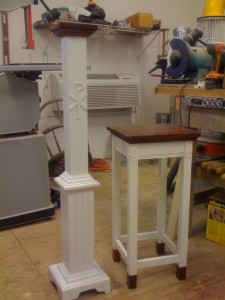
It turns out there is a pretty good market for we semi-pro woodworkers in the _______ furniture market. This all got started last year when my son graduated from a Master’s program and at his first job decided he needed a candle stand to enhance the services. He and I designed one and I mocked up a couple of them to get the scale right and then made one to match the _______ furniture where he works.
I popped it up on my Etsy site and lo and behold, I sold five more of them all over the country. Actually got tired of making them before it was over. Then last summer, one of the _______ who bought a candle stand wanted me to make an Advent candle stand to match their _______ furniture. That turned out pretty well and they were happy with it. I left it up on the Etsy site and maybe next year I will get some additional sales out of that one too. It is such a thrill to know that _______ all over the country are using my stuff. I’m making two more this season, one for my own _______ and another for a friend up the road who is Pastor of a _______.

In making the new stands, I found a new router bit. When I make a column of four pieces joined at right angles, a lock joint router bit is the thing to use. These bits cut a joint with a tongue and a slot which fit together when turned at ninety degrees to each other. The joint locks together and is so firm that clamping is almost not necessary. The bit is a little bit touchy to set up correctly and it does require a router table. But man, this thing works like a charm. You can buy it at Highland.
The point of all this is you never know where sales will come from. There is a market out there for your stuff – you just have to find it and work it. Buy more tools, make more stuff, sell it, and buy more tools.
Last year I found a new sales avenue for my Etsy site. I wanted you to know about it, but I don’t want you intruding on my sales so I decided to write about it and then redact it. Here it is.

Candle Stand
I popped it up on my Etsy site and lo and behold, I sold five more of them all over the country. Actually got tired of making them before it was over. Then last summer, one of the _______ who bought a candle stand wanted me to make an Advent candle stand to match their _______ furniture. That turned out pretty well and they were happy with it. I left it up on the Etsy site and maybe next year I will get some additional sales out of that one too. It is such a thrill to know that _______ all over the country are using my stuff. I’m making two more this season, one for my own _______ and another for a friend up the road who is Pastor of a _______.

Advent Stand on the Left (Sudbury UMC, MA)
The point of all this is you never know where sales will come from. There is a market out there for your stuff – you just have to find it and work it. Buy more tools, make more stuff, sell it, and buy more tools.
Thursday, February 3, 2011
Taming the skew
Ok, let’s get all the puns out of the way. Try not to skew this up. The taming of the skew. Situation normal, all skewed up. Is that all of them? Can you think of any more?
What all this is coming to is, I am finally taking a turning class on using the skew. Can we be honest here for just a moment? I am scared of the thing. I won’t use it in my shop. When I pick up my skew, it catches before I even walk over to the lathe. You can imagine what happens when I actually touch the wood with it. Then when I finally turn on the lathe, well, things just start to happen without warning. I watch other people use it and it is magical. They make all those coves, rounds, and steps and it is beautiful and so beyond me. When I took Peter Galbert’s chair class last fall at the High, he was the best I had ever seen with the skew. We had the option of bringing our own premade chair legs or using ones Peter made for us. I would have been out of luck if I tried to make my own before the class. Just for funsies, Peter made a chair leg during the class and I couldn’t believe how quickly and easily he turned it out. Wow!! After he completed it with just the skew, it was so smooth that he had to rough it up (not smooth it out, mind you) with sandpaper so it would take a finish. I may get there in about ten years of practice.
On February 9th Hal Simmons will teach a class at Highland on Taming the Skew. It is three hours from 5:30 to 8:30 pm. When I was in the business world, our staff sat down together and took a careful inventory of all the skills we needed to satisfy our clients. Any skills we did not have, we acquired by either hiring or training. I look at my woodworking skills the same way, except I don’t plan to hire anybody. That is why I keep a close eye on the classes offered at the Highland web site. This class will complete most of my turning skills and after that, it is a matter of practice. Sometimes you just need a little bit of help to keep from really skewing something up. Come on down and meet me there.
Subscribe to:
Posts (Atom)




